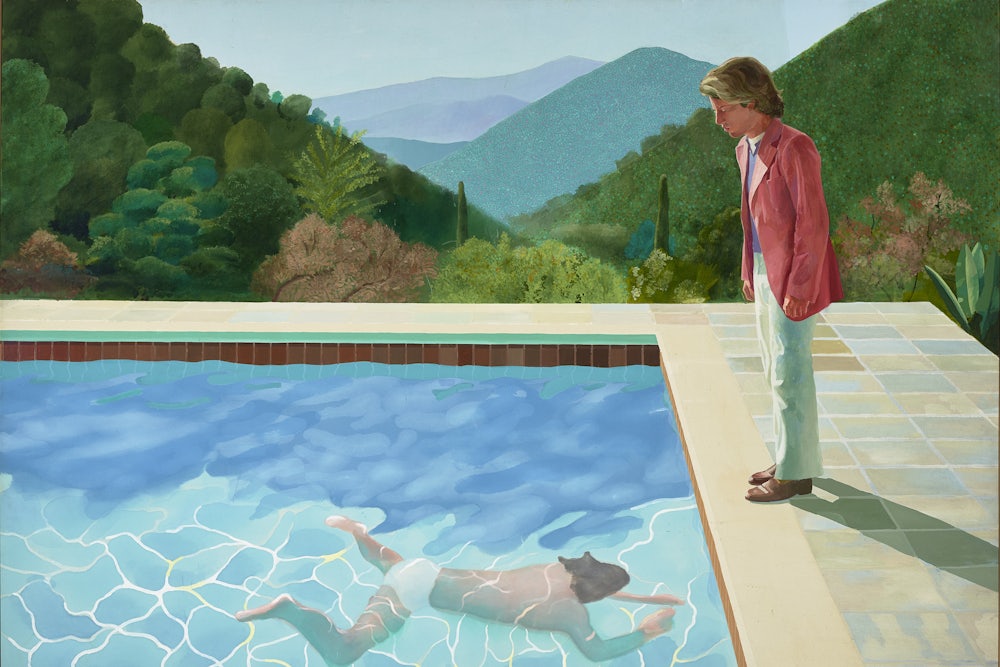To get to the David Hockney show, the person at the information desk told me, one must go up the stairs, turn left, hang a right at Rodin, but not wander into the Michelangelo by mistake. The Metropolitan Museum of Art is an enormous and overstuffed old place. Hockney’s work is lighter than air, each composition lifting the viewer up. It feels odd to go from his watery spaces into the dark, dark cavern of the Michelangelo exhibition, which is how most tourists this winter will experience these two shows. The casual viewer will drift from one room to the other, perhaps wandering next through the snowy-soft Monet and Pissarro rooms. They might see the corner that has two Van Goghs and three Gauguins jammed into it. Maybe they’ll remember the rooms as distinct, maybe not. Can Hockney—breezy savant, playful genius—breathe in such stifling conditions?
The exhibition has come to the Met via the Tate Britain and the Paris Pompidou, but New York is the last stop on its Fashion Week–ish journey. The works are from every era in David Hockney’s life. Here are the victorious early paintings of the 1962 art school graduate, who by the following year was a big star meeting the Queen Mother in a gold lamé jacket. Here are the iPad drawings of an old artist’s view out his bedroom window each morning. Here’s the Grand Canyon done in capsicum red. And in between—or perhaps hovering over them all, like a smell or a ghost—is an attempt to summarize a great man’s career.
Its center, of course, is A Bigger Splash (1967). Four rectangles (sky, villa, pool, and ground) float in a blank border, rudely slashed by the diagonal diving board. Until seeing the work in person, I’d never realized that the house is painted over the sky in such a way that you can see the blue at the lefthand edge of the house. This gives the painting a strongly graphic feel, as if it has been screen-printed in wonderful opaque inks for a magazine spread. That textural sense is fitting, since diving into a private swimming pool is a very aspirational idea. California, blue skies, and palm trees are from the vocabulary of advertising, but here they are made sublime. By raising the L.A. lifestyle up into the fine arts, Hockney doubles the magazine principle into a conceptual play on shallowness and depth. That famous splash indicates that the water must be deep, holding a submerged diver, but without it the pool would look as flat as a screen.
The question of depth is Hockney’s most charming. His “double portraits,” which fill a whole room at the Met, are all humming with it. Each work features two rounded subjects against a super-flat background. Wall hovers over carpet. In Christopher Isherwood and Don Bachardy (1968), the two men look like furniture come to life. Their chairs and the shutters behind them are so flat but so vibrant that they express an emotional dimension between the subjects, one that belongs more to beauty itself than to human beings.
Something about that play on depth makes Hockney stand up very well to screen representation. The colors look great on a computer monitor. But seen in person, Hockney’s experimentation with depth of field is surprisingly disorienting, as though you are drunk and keeping one eye closed to get your key into the lock of your front door. I walked around grinning like a tipsy dreamer.
There’s a connection between Hockney’s obsession with depth and the public’s view of him. The gold lamé jacket was a signature piece for the young painter, but it is also central to his reputation. When I think “David Hockney” I think round glasses; beautiful mop of bleached hair; swimming pools and palm trees; spiteful humor; rich shallowness. He’s just as famous as Lucian Freud or Francis Bacon or Tony Bevan, but so different from them. And do we take Hockney’s art more or less seriously because he is a gorgeous gay celebrity? Hockney never accepted the culture’s burden of gravitas, and has stayed funny and sweet despite being a very famous British male figurative painter. It’s what has stopped him getting mired in his own reputation, and the reason that his digital works feel driven by the same animus that painted the Grand Canyon in 1998.
Fame can be a swamp for an artist, and the Met does feel a little like a quagmire in comparison to Hockney’s works. The rooms aren’t quite big enough for his paintings to sit easily in them, nor can they accommodate his biggest works. It’s unfair to wish one museum were another, but the Whitney could have housed this show better.
Nestled at the heart of all the marble and shadows of the grand old Met, however, the Hockney show just about brings enough of its own light. When I visited it midweek, the gallery felt like a wholly different space. Michelangelo was full of infuriating tourists; Hockney had attracted children and strange elderly people, each with a smile glowing on their face.
David Hockney the personality is as much responsible for that levity and magic as David Hockney the painter. But lack of self-seriousness can liberate an oeuvre from the pantheon’s gluey trap. From sentimentality and from dustiness Hockney’s works are entirely free. This painter is still alive.
